| Listing 1 - 10 of 12 | << page >> |
Sort by
|
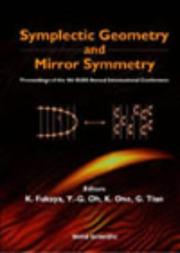
ISBN: 1281951382 9786611951382 9812799826 9789812799821 9789810247140 9810247141 Year: 2001 Publisher: River Edge, N.J. : World Scientific,
Abstract | Keywords | Export | Availability | Bookmark
 Loading...
Loading...Choose an application
- Reference Manager
- EndNote
- RefWorks (Direct export to RefWorks)
In 1993, M. Kontsevich proposed a conceptual framework for explaining the phenomenon of mirror symmetry. Mirror symmetry had been discovered by physicists in string theory as a duality between families of three-dimensional Calabi–Yau manifolds. Kontsevich's proposal uses Fukaya's construction of the A∞-category of Lagrangian submanifolds on the symplectic side and the derived category of coherent sheaves on the complex side. The theory of mirror symmetry was further enhanced by physicists in the language of D-branes and also by Strominger–Yau–Zaslow in the geometric set-up of (special) Lagrangian torus fibrations. It rapidly expanded its scope across from geometry, topology, algebra to physics. In this volume, leading experts in the field explore recent developments in relation to homological mirror symmetry, Floer theory, D-branes and Gromov–Witten invariants. Kontsevich-Soibelman describe their solution to the mirror conjecture on the abelian variety based on the deformation theory of A∞-categories, and Ohta describes recent work on the Lagrangian intersection Floer theory by Fukaya–Oh–Ohta–Ono which takes an important step towards a rigorous construction of the A∞-category. There follow a number of contributions on the homological mirror symmetry, D-branes and the Gromov–Witten invariants, e.g. Getzler shows how the Toda conjecture follows from recent work of Givental, Okounkov and Pandharipande. This volume provides a timely presentation of the important developments of recent years in this rapidly growing field.
Mirror symmetry --- Symplectic groups --- Groups, Symplectic --- Linear algebraic groups --- Symmetry (Physics)
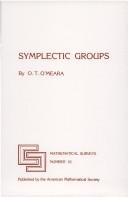
ISBN: 0821815164 Year: 1978 Publisher: Providence (R.I.): American Mathematical Society
Abstract | Keywords | Export | Availability | Bookmark
 Loading...
Loading...Choose an application
- Reference Manager
- EndNote
- RefWorks (Direct export to RefWorks)
Group theory --- 512 --- Isomorphisms (Mathematics) --- Symplectic groups --- Groups, Symplectic --- Linear algebraic groups --- Categories (Mathematics) --- Morphisms (Mathematics) --- Set theory --- Algebra --- 512 Algebra
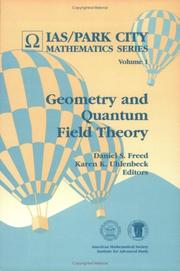
ISBN: 0821804006 Year: 1995 Publisher: Providence American Mathematical Society. Institute for advanced study
Abstract | Keywords | Export | Availability | Bookmark
 Loading...
Loading...Choose an application
- Reference Manager
- EndNote
- RefWorks (Direct export to RefWorks)
Topological groups. Lie groups --- Mathematical physics --- Lie groups --- Quantum field theory --- Symplectic groups --- Congresses. --- 530.1 --- Groups, Symplectic --- Linear algebraic groups --- Basic principles of physics --- 530.1 Basic principles of physics --- Congresses

ISSN: 00659266 ISBN: 0821804820 Year: 1996 Publisher: Providence (R.I.): American Mathematical Society
Abstract | Keywords | Export | Availability | Bookmark
 Loading...
Loading...Choose an application
- Reference Manager
- EndNote
- RefWorks (Direct export to RefWorks)
Group theory --- p-adic fields. --- Groupes p-adiques. --- Symplectic groups. --- Groupes symplectiques. --- Representations of groups. --- Représentations de groupes. --- p-adic fields --- Representations of groups --- Symplectic groups --- Groups, Symplectic --- Linear algebraic groups --- Group representation (Mathematics) --- Groups, Representation theory of --- Algebraic fields --- p-adic numbers

ISSN: 00659266 ISBN: 082180765X Year: 1998 Publisher: Providence (R.I.): American Mathematical Society
Abstract | Keywords | Export | Availability | Bookmark
 Loading...
Loading...Choose an application
- Reference Manager
- EndNote
- RefWorks (Direct export to RefWorks)
Group theory --- Functional analysis --- Symplectic groups. --- Groupes symplectiques. --- p-adic fields. --- Groupes p-adiques. --- Representations of groups. --- Représentations de groupes. --- p-adic fields --- Representations of groups --- Symplectic groups --- Groups, Symplectic --- Linear algebraic groups --- Group representation (Mathematics) --- Groups, Representation theory of --- Algebraic fields --- p-adic numbers

ISBN: 0821825496 Year: 1993 Publisher: Providence (R.I.): American Mathematical Society
Abstract | Keywords | Export | Availability | Bookmark
 Loading...
Loading...Choose an application
- Reference Manager
- EndNote
- RefWorks (Direct export to RefWorks)
Group theory --- p-adic fields --- Hecke algebras --- Representations of groups --- Symplectic groups --- Groups, Symplectic --- Linear algebraic groups --- Group representation (Mathematics) --- Groups, Representation theory of --- Algebras, Hecke --- Group algebras --- Algebraic fields --- p-adic numbers --- Groupes symplectiques --- Représentations de groupes --- Hecke, Algèbres de --- Groupes symplectiques. --- Représentations de groupes. --- Hecke, Algèbres de.
Book
ISBN: 9781470434922 147043492X Year: 2019 Publisher: Providence, RI : American Mathematical Society,
Abstract | Keywords | Export | Availability | Bookmark
 Loading...
Loading...Choose an application
- Reference Manager
- EndNote
- RefWorks (Direct export to RefWorks)
Symplectic geometry. --- Symplectic groups. --- Domains of holomorphy. --- Géométrie symplectique. --- Groupes symplectiques. --- Domaines d'holomorphie. --- Géométrie symplectique --- Groupes symplectiques --- Domaines d'holomorphie --- Symplectic geometry --- Symplectic groups --- Domains of holomorphy --- Holomorphy domains --- Analytic continuation --- Functions of several complex variables --- Groups, Symplectic --- Linear algebraic groups --- Geometry, Differential
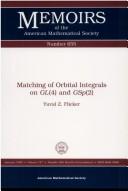
ISSN: 00659266 ISBN: 0821809598 Year: 1999 Publisher: Providence (R.I.): American Mathematical Society
Abstract | Keywords | Export | Availability | Bookmark
 Loading...
Loading...Choose an application
- Reference Manager
- EndNote
- RefWorks (Direct export to RefWorks)
Functional analysis --- Symplectic groups. --- Groupes symplectiques --- Trace formulas. --- Formules de trace --- Orbit method. --- Orbites, Méthode des --- Representations of groups. --- Représentations de groupes --- Orbit method --- Representations of groups --- Symplectic groups --- Trace formulas --- Formulas, Trace --- Automorphic forms --- Discontinuous groups --- Groups, Symplectic --- Linear algebraic groups --- Group representation (Mathematics) --- Groups, Representation theory of --- Group theory --- Method of orbits --- Orbits, Method of --- Representations of algebras --- Groupes symplectiques. --- Formules de trace. --- Orbites, Méthode des. --- Représentations de groupes.
Book
ISBN: 9781470431020 1470431025 Year: 2018 Publisher: Providence AMS
Abstract | Keywords | Export | Availability | Bookmark
 Loading...
Loading...Choose an application
- Reference Manager
- EndNote
- RefWorks (Direct export to RefWorks)
"We study the non-semisimple terms in the geometric side of the Arthur trace formula for the split symplectic similitude group and the split symplectic group of rank 2 over any algebraic number field. In particular, we express the global coefficients of unipotent orbital integrals in terms of Dedekind zeta functions, Hecke L-functions, and the Shintani zeta function for the space of binary quadratic forms."--
Selberg trace formula. --- Trace formulas. --- Geometry, Algebraic. --- Symplectic groups. --- Formule de trace de Selberg --- Formules de trace --- Géométrie algébrique --- Groupes symplectiques --- Selberg, Formule de trace de --- Selberg trace formula --- Trace formulas --- Geometry, Algebraic --- Symplectic groups --- Functions, Zeta --- Number theory --- Riemann surfaces --- Groups, Symplectic --- Linear algebraic groups --- Algebraic geometry --- Geometry --- Formulas, Trace --- Automorphic forms --- Discontinuous groups --- Representations of groups --- Selberg, Formule de trace de. --- Formules de trace. --- Géométrie algébrique. --- Groupes symplectiques.
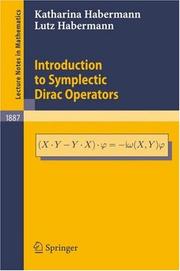
ISBN: 9783540334200 3540334203 9786610635221 1280635223 3540334211 Year: 2006 Publisher: Berlin, Germany : Springer,
Abstract | Keywords | Export | Availability | Bookmark
 Loading...
Loading...Choose an application
- Reference Manager
- EndNote
- RefWorks (Direct export to RefWorks)
One of the basic ideas in differential geometry is that the study of analytic properties of certain differential operators acting on sections of vector bundles yields geometric and topological properties of the underlying base manifold. Symplectic spinor fields are sections in an L^2-Hilbert space bundle over a symplectic manifold and symplectic Dirac operators, acting on symplectic spinor fields, are associated to the symplectic manifold in a very natural way. Hence they may be expected to give interesting applications in symplectic geometry and symplectic topology. These symplectic Dirac operators are called Dirac operators, since they are defined in an analogous way as the classical Riemannian Dirac operator known from Riemannian spin geometry. They are called symplectic because they are constructed by use of the symplectic setting of the underlying symplectic manifold. This volume is the first one that gives a systematic and self-contained introduction to the theory of symplectic Dirac operators and reflects the current state of the subject. At the same time, it is intended to establish the idea that symplectic spin geometry and symplectic Dirac operators may give valuable tools in symplectic geometry and symplectic topology, which have become important fields and very active areas of mathematical research.
Symplectic geometry. --- Symplectic and contact topology. --- Symplectic groups. --- Dirac equation. --- Géométrie symplectique --- Topologie symplectique et de contact --- Groupes symplectiques --- Dirac, Equation de --- Symplectic geometry --- Symplectic and contact topology --- Symplectic groups --- Dirac equation --- Mathematics --- Physical Sciences & Mathematics --- Geometry --- Algebra --- Clifford algebras. --- Differential operators. --- Operators, Differential --- Geometric algebras --- Mathematics. --- Global analysis (Mathematics). --- Manifolds (Mathematics). --- Differential geometry. --- Differential Geometry. --- Global Analysis and Analysis on Manifolds. --- Differential geometry --- Geometry, Differential --- Topology --- Analysis, Global (Mathematics) --- Differential topology --- Functions of complex variables --- Geometry, Algebraic --- Math --- Science --- Differential equations --- Operator theory --- Differential equations, Partial --- Quantum field theory --- Wave equation --- Algebras, Linear --- Global differential geometry. --- Global analysis. --- Global analysis (Mathematics) --- Groups, Symplectic --- Linear algebraic groups --- Topology, Symplectic and contact
| Listing 1 - 10 of 12 | << page >> |
Sort by
|

 Search
Search Feedback
Feedback About UniCat
About UniCat  Help
Help News
News